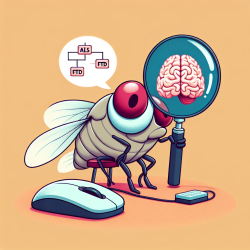Introduction
In the world of neurodegenerative diseases, Amyotrophic Lateral Sclerosis (ALS) and Frontotemporal Dementia (FTD) have long been a challenging puzzle. These conditions are linked by a common culprit: TDP-43 proteinopathy. Recent research has taken a significant leap forward by using Drosophila, or fruit flies, to model these diseases, revealing shared and neuron-specific targets across ALS and FTD relevant circuits. This blog delves into how this research can enhance the skills of practitioners and encourage further exploration.
The Breakthrough Research
The study titled "Modelling TDP-43 proteinopathy in Drosophila uncovers shared and neuron-specific targets across ALS and FTD relevant circuits" provides groundbreaking insights. The researchers overexpressed TDP-43 in Drosophila Kenyon cells, a part of the mushroom body (MB) circuit, which mirrors vertebrate cortical networks. This model successfully recapitulates dementia-relevant pathological features, including age-dependent neuronal loss and behavioral deficits in working memory and sleep.
Key Findings
- The research identified several candidate mRNA targets of TDP-43 in MBs, some unique to the MB circuit and others shared with motor neurons.
- One significant finding was the glypican Dally-like-protein (Dlp), which showed reduced expression during aging. Overexpression of Dlp mitigated TDP-43 dependent working memory deficits.
- These findings suggest that circuit-specific Drosophila models can uncover shared or disease-specific molecular mechanisms across TDP-43 proteinopathies.
Implications for Practitioners
For practitioners, these findings offer a new perspective on approaching ALS and FTD. By understanding the molecular targets and pathways involved, interventions can be more targeted and effective. This research encourages practitioners to consider the potential of using Drosophila models in their work, either for direct application or as a basis for further research.
Encouraging Further Research
This study is a call to action for further research. The use of Drosophila as a model organism opens up numerous possibilities for exploring the genetic and molecular underpinnings of neurodegenerative diseases. Practitioners are encouraged to delve deeper into these findings, explore new therapeutic targets, and consider the broader implications for treatment strategies.
Conclusion
The research on TDP-43 proteinopathy in Drosophila is a testament to the power of model organisms in unraveling complex diseases. For practitioners, it offers a pathway to enhance their skills and contribute to a growing body of knowledge that could revolutionize treatment for ALS and FTD. To read the original research paper, please follow this link: Modelling TDP-43 proteinopathy in Drosophila uncovers shared and neuron-specific targets across ALS and FTD relevant circuits.










